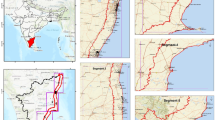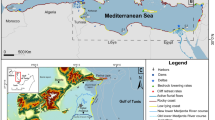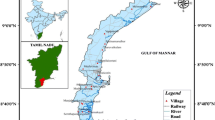Abstract
Future Composite Coastal Risk Index (CCRI) has been calculated to strengthen the development programs in the context of biodiversity conservation and sustainable management of natural resources along the Andaman coast. Total thirty-one parameters are used in the Analytic Hierarchy Process (AHP) model to prepare the risk zone which is segmented into four groups for individual group-wise risk assessment. Land use and Land cover (LULC) have been prepared using supervised classification techniques with 6000 signatures. Representative Concentration Pathways (RCPs) based climatic data and population projection information play a major role, which has not been used previously for risk investigation in this study area. The risk zones of 2018 and the LULC classes have been validated by 978 field sample point and finally tehsil wise risk factors have been extracted using sensitivity analysis. The overall operation reflects a significant increase (4.35%) in the very high-risk zones in the absence of mangrove and coral ecosystem in 2030 compared to 2018. A large number of fishermen are trying to shift their primary occupation due to the unavailability of sufficient fishes in the near-shore regions, which is an indication of drastic changes in coastal ecosystems over the region in the last 3 decades. Therefore, the prediction of future coastal landscape in the absence of mangrove–coral ecosystem will draw a major concern in development planning which will strengthen the United Nation Development Program (UNDP) climate change mitigation, ecological restoration and biodiversity conservation planning, sustainable livelihood management practices, future research work in risk mitigation and management field.







Similar content being viewed by others
References
Abdel-Basset M, Mohamed M, Smarandache F (2018) An extension of neutrosophic AHP–SWOT analysis for strategic planning and decision-making. Symmetry 10(4):116. https://doi.org/10.3390/sym10040116
Acharyya SK (2007) Collisional emplacement history of the Naga-Andaman ophiolites and the position of the eastern Indian suture. J Asian Earth Sci 29(2–3):229–242. https://doi.org/10.1016/j.jseaes.2006.03.003
Akay AO, Demir M, Akgul M (2018) Assessment of risk factors in forest road design and construction activities with a fuzzy analytic hierarchy process approach in Turkey. Environ Monit Assess 190(9):561. https://doi.org/10.1007/s10661-018-6948-0
Alongi DM (2002) Present state and future of the world’s mangrove forests. Environ Conserv 29(3):331–349. https://doi.org/10.1017/S0376892902000231
Alongi DM (2020) Global significance of mangrove blue carbon in climate change mitigation. Sci 2(3):67. https://doi.org/10.3390/sci2030067
Alonso JA, Lamata MT (2006) Consistency in the analytic hierarchy process: a new approach. Internat J Uncertain Fuzziness Knowl-Based Syst 14(04):445–459. https://doi.org/10.1142/S0218488506004114
Bandopadhyay PC, Carter A (2017) Geological framework of the Andaman-Nicobar Islands. Geol Soc 47(1):75–93. https://doi.org/10.1144/M47.6
Bouma TJ, Van Belzen J, Balke T, Zhu Z, Airoldi L, Blight AJ, Davies AJ, Galvan C, Hawkins SJ, Hoggart SP, Lara JL (2014) Identifying knowledge gaps hampering application of intertidal habitats in coastal protection: opportunities and steps to take. Coast Eng 87:147–157. https://doi.org/10.1016/j.coastaleng.2013.11.014
Carter TR, Jones RN, Lu X, Bhadwal S, Conde C, Mearns LO, O Neill BC, Rounsevell MDA, Zurek MB (2007). New assessment methods and the characterization of future conditions. In ‘Climate Change 2007: impacts, adaptation and vulnerability, Contribution of Working Group II to the Fourth Assessment Report of the Intergovernmental Panel on Climate Change. (Eds ML Parry, OF Canziani, JP Palutikof, PJ van der Linden, CE Hanson), 133–171. Permalink: http://hdl.handle.net/102.100.100/124517?index=1
Chakraborty S, Sahoo S, Majumdar D, Saha S, Roy S (2019) Future mangrove suitability assessment of Andaman to strengthen sustainable development. J Clean Prod 234:597–614. https://doi.org/10.1016/j.jclepro.2019.06.257
Chaturvedi RK, Joshi J, Jayaraman M, Bala G, Ravindranath NH (2012) Multi-model climate change projections for India under representative concentration pathways. Curr Sci 103(7):791–802. https://www.jstor.org/stable/24088836
Cheung WW, Lam VW, Sarmiento JL, Kearney K, Watson REG, Zeller D, Pauly D (2010) Large-scale redistribution of maximum fisheries catch potential in the global ocean under climate change. Glob Change Biol 16(1):24–35. https://doi.org/10.1111/j.1365-2486.2009.01995.x
Chong-Hai XU, Ying X (2012) The projection of temperature and precipitation over China under RCP scenarios using a CMIP5 multi-model ensemble. Atmos Oceanic Sci Lett 5(6):527–533. https://doi.org/10.1080/16742834.2012.11447042
Chow J (2018) Mangrove management for climate change adaptation and sustainable development in coastal zones. J Sustain 37(2):139–156. https://doi.org/10.1080/10549811.2017.1339615
Cinner JE, McClanahan TR, Graham NA, Daw TM, Maina J, Stead SM, Wamukota A, Brown K, Bodin Ö (2012) Vulnerability of coastal communities to key impacts of climate change on coral reef fisheries. Glob Environ Chang 22(1):12–20. https://doi.org/10.1016/j.gloenvcha.2011.09.018
Cinner JE, Adger WN, Allison EH, Barnes ML, Brown K, Cohen PJ, Gelcich S, Hicks CC, Hughes TP, Lau J, Marshall NA (2018) Building adaptive capacity to climate change in tropical coastal communities. Nat Clim Chang 8(2):117. https://doi.org/10.1038/s41558-017-0065-x
De Andreis S, Ricci PE (2005) Modelling population growth vialaguerre-type exponentials. Math Comput Model 42(13):1421–1428. https://doi.org/10.1016/j.mcm.2005.01.037
De Andrade TS, de Oliveira Sousa PHG, Siegle E (2019) Vulnerability to beach erosion based on a coastal processes approach. Appl Geogr 102:12–19. https://doi.org/10.1016/j.apgeog.2018.11.003
De Serio F, Armenio E, Mossa M, Petrillo A (2018) How to define priorities in coastal vulnerability assessment? Geosciences 8(11):415. https://doi.org/10.3390/geosciences8110415
Dhar A, Sahoo S, Dey S, Sahoo M (2014) Evaluation of recharge and groundwater dynamics of a shallow alluvial aquifer in central ganga basin, Kanpur (India). Nat Resour Res 23(4):409–422. https://doi.org/10.1007/s11053-014-9251-y
Di Paola G, Aucelli PPC, Benassai G, Iglesias J, Rodríguez G, Rosskopf CM (2018) The assessment of the coastal vulnerability and exposure degree of Gran Canaria Island (Spain) with a focus on the coastal risk of Las Canteras Beach in Las Palmas de Gran Canaria. J Coast Conserv 22(5):1001–1015. https://doi.org/10.1007/s11852-017-0574-9
Dos SPH, Neves SM, Sant ADO, de Oliveira CH, Carvalho HD (2018) The analytic hierarchy process supporting decision making for sustainable development: an overview of applications. J Cleaner Prod 212:119–138. https://doi.org/10.1016/j.jclepro.2018.11.270
Estoque RC, Myint SW, Wang C, Ishtiaque A, Aung TT, Emerton L, Ooba M, Hijioka Y, Mon MS, Wang Z, Fan C (2018) Assessing environmental impacts and change in Myanmar’s mangrove ecosystem service value due to deforestation (2000–2014). Glob Change Biol 24(11):5391–5410. https://doi.org/10.1111/gcb.14409
Feller IC, Friess DA, Krauss KW, Lewis RR (2017) The state of the world’s mangroves in the 21st century under climate change. Hydrobiologia 803(1):1–12. https://doi.org/10.1007/s10750-017-3331-z
Goutham-Bharathi MP, Roy SD, Krishnan P, Kaliyamoorthy M, Immanuel T (2014) Species diversity and distribution of mangroves in Andaman and Nicobar Islands. India Botanica Marina 57(6):421–432. https://doi.org/10.1515/bot-2014-0033
Green EP, Clark CD, Mumby PJ, Edwards AJ, Ellis AC (1998) Remote sensing techniques for mangrove mapping. Int J Remote Sens 19(5):935–956. https://doi.org/10.1080/014311698215801
Hamurcu M, Eren T (2018) Transportation planning with analytic hierarchy process and goal programming. Internat Adv Res Eng J 2(2): 92–97. https://dergipark.org.tr/en/pub/iarej/issue/38845/402522
Hughes TP, Kerry JT, Álvarez-Noriega M, Álvarez-Romero JG, Anderson KD, Baird AH, Babcock RC, Beger M, Bellwood DR, Berkelmans R, Bridge TC (2017) Global warming and recurrent mass bleaching of corals. Nature 543(7645):373. https://doi.org/10.1038/nature21707
Ishtiaque A, Eakin H, Chhetri N, Myint SW, Dewan A, Kamruzzaman M (2019) Examination of coastal vulnerability framings at multiple levels of governance using spatial MCDA approach. Ocean Coast Manag 171:66–79. https://doi.org/10.1016/j.ocecoaman.2019.01.020
Jennerjahn TC, Gilman E, Krauss KW, Lacerda LD, Nordhaus I, Wolanski E (2017) Mangrove ecosystems under climate change. In Mangrove ecosystems: a global biogeographic perspective. Springer
Jha DK, Kirubagaran R, Vinithkumar NV, Dharani G, Madeswaran P (2019) The Andaman and Nicobar islands in world seas: an environmental evaluation. Academic Press, pp 185–209
Kahsay A, Haile M, Gebresamuel G, Mohammed M (2018) Land suitability analysis for sorghum crop production in northern semi-arid Ethiopia: application of GIS-based fuzzy AHP approach. Cogent Food Agric 4(1):1507184. https://doi.org/10.1080/23311932.2018.1507184
Kantamaneni K, Phillips M, Thomas T, Jenkins R (2018) Assessing coastal vulnerability: development of a combined physical and economic index. Ocean Coast Manag 158:164–175. https://doi.org/10.1016/j.ocecoaman.2018.03.039
Kiruba-Sankar R, Krishnan P, Roy SD, Angel JRJ, Goutham-Bharathi MP, Kumar KL, Ragavan P, Kaliyamoorthy M, Muruganandam R, Rajakumari S, Purvaja R (2018) Structural complexity and tree species composition of mangrove forests of the Andaman Islands. India J Coastal Conserv 22(2):217–234. https://doi.org/10.1007/s11852-017-0588-3
Lins-de-Barros FM (2017) Integrated coastal vulnerability assessment: a methodology for coastal cities management integrating socioeconomic, physical and environmental dimensions-Case study of Região dos Lagos, Rio de Janeiro, Brazil. Ocean Coast Manag 149:1–11. https://doi.org/10.1016/j.ocecoaman.2017.09.007
Majumdar D, Chakraborty S, Saha S, Datta D (2019) Geospatial analysis of the effects of tsunami on coral and mangrove ecosystems of Mayabunder in Andaman Islands. India Braz J Oceanogr. https://doi.org/10.1590/s1679-87592019025806715
Malekmohammadi B, Blouchi LR (2014) Ecological risk assessment of wetland ecosystems using multi criteria decision making and geographic information system. Ecol Ind 41:133–144. https://doi.org/10.1016/j.ecolind.2014.01.038
Martínez-López J, Teixeira H, Morgado M, Almagro M, Sousa AI, Villa F, Balbi S, Genua-Olmedo A, Nogueira AJ, Lillebø AI (2019) Participatory coastal management through elicitation of ecosystem service preferences and modelling driven by “coastal squeeze.” Sci Total Environ 652:1113–1128. https://doi.org/10.1016/j.scitotenv.2018.10.309
Mokrech M, Nicholls RJ, Dawson RJ (2012) Scenarios of future built environment for coastal risk assessment of climate change using a GIS-based multicriteria analysis. Environ Plann B Plann Des 39(1):120–136. https://doi.org/10.1068/b36077
Mumby PJ, Edwards AJ, Arias-González JE, Lindeman KC, Blackwell PG, Gall A, Gorczynska MI, Harborne AR, Pescod CL, Renken H, Wabnitz CC (2004) Mangroves enhance the biomass of coral reef fish communities in the Caribbean. Nature 427(6974):533. https://doi.org/10.1038/nature02286
Nagelkerken I, Van der Velde G, Gorissen MW, Meijer GJ, Van’t Hof T, Den Hartog C (2000) Importance of mangroves, seagrass beds and the shallow coral reef as a nursery for important coral reef fishes, using a visual census technique. Estuar Coast Shelf Sci 51(1):31–44. https://doi.org/10.1006/ecss.2000.0617
Nayak PK, Berkes F (2019) Interplay between local and global: Change processes and small-scale fisheries. In transdisciplinarity for small-scale fisheries governance. Springer, pp 203–220
Nehru P, Balasubramanian P (2018) Mangrove species diversity and composition in the successional habitats of Nicobar Islands, India: a post-tsunami and subsidence scenario. For Ecol Manage 427:70–77. https://doi.org/10.1016/j.foreco.2018.05.063
Ng K, Borges P, Phillips MR, Medeiros A, Calado H (2019) An integrated coastal vulnerability approach to small islands: the Azores case. Sci Total Environ 690:1218–1227. https://doi.org/10.1016/j.scitotenv.2019.07.013
Nicholls RJ, Cazenave A (2010) Sea-level rise and its impact on coastal zones. Science 328(5985):1517–1520. https://doi.org/10.1126/science.1185782
Pelegri SP, Twilley RR (1998) Heterotrophic nitrogen fixation (acetylene reduction) during leaf-litter decomposition of two mangrove species from South Florida, USA. Mar Biol 131(1):53–61. https://doi.org/10.1007/s002270050296
Pereira JM, Duckstein L (1993) A multiple criteria decision-making approach to GIS-based land suitability evaluation. Int J Geogr Inf Sci 7(5):407–424. https://doi.org/10.1080/02693799308901971
Porwal MC, Padalia H, Roy PS (2012) Impact of tsunami on the forest and biodiversity richness in Nicobar Islands (Andaman and Nicobar Islands), India. Biodivers Conserv 21(5):1267–1287. https://doi.org/10.1007/s10531-011-0214-x
Pricope NG, Halls JN, Rosul LM (2019) Modeling residential coastal flood vulnerability using finished-floor elevations and socio-economic characteristics. J Environ Manage 237:387–398. https://doi.org/10.1016/j.jenvman.2019.02.078
Ragavan P, Saxena M, Saxena A, Mohan PM, Sachithanandam V, Coomar T (2014) Floral composition and taxonomy of mangroves of Andaman and Nicobar Islands, NISCAIR-CSIR, India. 0975–1033. http://hdl.handle.net/123456789/28974
Rahadianto H, Fariza A, Hasim JAN (2015) Risk-level assessment system on Bengawan Solo River basin flood prone areas using analytic hierarchy process and natural breaks: Study case: East Java. In 2015 international conference on data and software engineering (ICoDSE), IEEE. 195–200. https://doi.org/10.1109/ICODSE.2015.7436997
Ramakrishnan R, Gladston Y, Kumar NL, Rajput P, Murali RM, Rajawat AS (2020) Impact of 2004 co-seismic coastal uplift on the mangrove cover along the North Andaman Islands. Reg Environ Change 20(1):1–12. https://doi.org/10.1007/s10113-020-01608-7
Sahoo S, Dhar A, Kar A (2016) Environmental vulnerability assessment using grey analytic hierarchy process based model. Environ Impact Assess Rev 56:145–154. https://doi.org/10.1016/j.eiar.2015.10.002
Sánchez-Arcilla A, García-León M, Gracia V, Devoy R, Stanica A, Gault J (2016) Managing coastal environments under climate change: pathways to adaptation. Sci Total Environ 572:1336–1352. https://doi.org/10.1016/j.scitotenv.2016.01.124
Singh LK, Jha MK, Chowdary VM (2018) Assessing the accuracy of GIS-based multi-criteria decision analysis approaches for mapping groundwater potential. Ecol Ind 91:24–37. https://doi.org/10.1016/j.ecolind.2018.03.070
Sippo JZ, Lovelock CE, Santos IR, Sanders CJ, Maher DT (2018) Mangrove mortality in a changing climate: an overview. Estuar Coast Shelf Sci 215:241–249. https://doi.org/10.1016/j.ecss.2018.10.011
Tamai K (2010) Effects of environmental factors and soil properties on topographic variations of soil respiration. Biogeosciences 7(3):1133–1142. https://doi.org/10.5194/bg-7-1133-2010
Uddin MN, Islam AS, Bala SK, Islam GT, Adhikary S, Saha D, Haque S, Fahad MGR, Akter R (2019) Mapping of climate vulnerability of the coastal region of Bangladesh using principal component analysis. Appl Geogr 102:47–57. https://doi.org/10.1016/j.apgeog.2018.12.011
Valiela I, Bowen JL, York JK (2001) Mangrove forests: one of the world’s threatened major tropical environments: at least 35% of the area of mangrove forests has been lost in the past two decades, losses that exceed those for tropical rain forests and coral reefs, two other well-known threatened environments. Bioscience 51(10):807–815. https://doi.org/10.1641/0006-3568(2001)051[0807:MFOOTW]2.0.CO;2
Vinithkumar NV, Sathish T, Das AK, Sivaperuman C, Raghunathan C, Dharani G, Kirubagaran R, Sujathkumar NV (2008) Marine ecosystems of andaman and nicobar islands-species abundance and distribution in biodiversity and climate change adaptation in tropical Islands. Academic Press, pp 217–256
Zhang R, Zhang X, Yang J, Yuan H (2013) Wetland ecosystem stability evaluation by using analytical hierarchy process (AHP) approach in Yinchuan Plain, China. Math Comput Model 57(3–4):366–374. https://doi.org/10.1016/j.mcm.2012.06.014
Acknowledgements
This study received financial support (Fellowship Reference No. SR/WOS-A/EA-1014/2015 (G), Dated 31.05.2016) extended by the Women Scientist Scheme (WOS-A), Department of Science and Technology, Delhi, India to the corresponding author. Authors are thankful to Dr. Debajit Datta (Mentor, DST WOS-A fellowship in Jadavpur University), Divisional Forest Officers, and Additional PCCF of Forest (Andaman Forest Office), and Dr. K. Dharanirajan, Assistant Professor, Pondicherry University for their noticeable support in filed investigation and knowledge sharing.
Author information
Authors and Affiliations
Corresponding author
Additional information
Publisher's Note
Springer Nature remains neutral with regard to jurisdictional claims in published maps and institutional affiliations.
Supplementary Information
Below is the link to the electronic supplementary material.
Rights and permissions
About this article
Cite this article
Chakraborty, S., Majumdar, D., Sahoo, S. et al. Assessment of future coastal risk zones along the Andaman coast to strengthen sustainable development. Environ Earth Sci 80, 637 (2021). https://doi.org/10.1007/s12665-021-09940-9
Received:
Accepted:
Published:
DOI: https://doi.org/10.1007/s12665-021-09940-9




